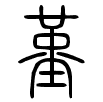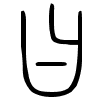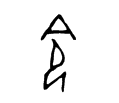The bronze script of character Diligent is
The left is character Viola - 堇 (Post 460), the right long curve is character Power - 力 (Post 168), which originally means a plow. A person who uses plow the violet and grass to plant crops, is diligent.Tuesday, November 30, 2021
Amazing Chinese Characters (461) Diligent - 勤
Monday, November 29, 2021
Amazing Chinese Characters (460) Viola - 堇
The bronze script of character Viola is
The top is the flower of viola, the middle are the leaves and stem of viola, the bottom is character Mountain.
The Dictionary of Pictography explanation is that the top is a person who shouts or cry while being hanged, and burnt on the bottom. However the bottom
Friday, November 26, 2021
Amazing Chinese Characters (459) Slippery - 滑
The big seal script of character Slippery (or Slip) is
The left is character Water (Post 13), the right is character Bone (Post 458). The Water means liquid, which could be oil. No matter it is oil or water, when the bone gets wet, it is slippery. There is another explanation by Su Shi - 苏轼 (Song Dynasty), one of the most famous poet in Chinese history, he thinks that the character means "The bone of water", which is ice. Of course, ice is slippery. I like the explanation .
The small seal script of the character is
The left is Water, the right is Bone.Thursday, November 25, 2021
Amazing Chinese Characters (458) Bone - 骨
The shell bone scripts of character Bone are




Saturday, November 20, 2021
Amazing Chinese Characters (457) All - 皆
The bronze script of character All is
The top is two person, the bottom is character 曰 - Say (Post 341). All people say something at the same time.Amazing Chinese Characters (456) White - 白
The bronze script of character White is
Sunday, November 14, 2021
Amazing Chinese Characters (455) Order from King or Emperor - 旨
Shell bone script of character Order from King or Emperor
The top is character Person (Post 57), the bottom is character Mouth (Post 16). A person makes order by his mouth.Wednesday, November 10, 2021
Amazing Chinese Characters (454) Here - 此
The shell bone script of character Dragger is
The left is character Foot (Post 93), the right is character Person (Post 37), but facing right (original Person is facing left). A foot of the person is where he stands: here he is.
The left is Foot, the right is Person.
The left is Foot, the right is Person.
The left is Foot, the right is character 匕 - Dragger (Post 453). Just I discussed in Post 453, character 匕 is not clear on its meaning, originally is Person, but gradually shifting to Dragger. From the meaning of this character, the right part should be a Person, not a Dragger.
If we re-read Post 453, the right part originally means Mother, so "A foot near Mother" means a physical and mental home for anyone: Here, I am from Here, belong to Here.
The left is Foot, the right is character 匕.
The song typeface of the character is
此
Amazing Chinese Characters (453) Dragger - 匕
The shell bone script of character Dragger is
The character has two meanings:
1, the dragger if it is an independent character, or used in word 匕首.
2, a person if it is part of a character.
How did the character have Dragger meaning? Probably there was some draggers in the ancient time which have this kind shape.
The situation is similar to character 月: which means Moon if it is used as a character, but means Body, or Organ or Meat if it is a part of a character.
Amazing Chinese Characters (703) Axe - 斧
The shell bone script of character Axe is It looks like a modern axe. However, the above shell one script only listed in 《在线汉语字典》(The Online...

-
This post has been collected in book "Learn Chinese from Pictography" published on Amazon. You could find it by clicking the follo...
-
Chinese is difficult to learn, which is not true. Actually, Chinese characters are very pictography, or ideogram. Learning Chinese should be...
-
The big seal script of character Plow is The left is character Rake, the right is character Well, the dot in the middle of the square is an...





















































